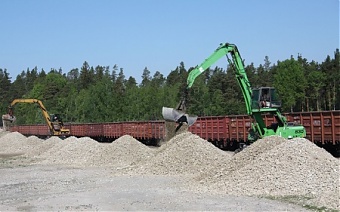Economics, Energy, Estonia, Good for Business, Railways, Transport
International Internet Magazine. Baltic States news & analytics
Friday, 26.04.2024, 19:03
Eesti Energia to direct 300,000 tons of limestone into circular economy in 2018
 Print version
Print version |
|---|
The limestone is waste rock extracted from the earth's crust as a by-product of oil shale mining. It includes the delivery of 100,000 tons of limestone to Graniidikeskus in Parnu County, 20,000 tons of which has already reached Parnu, Eesti Energia said.
In oil shale mining, limestone comes out of the ground together with oil shale, because oil shale and limestone are layered in the ground. Limestone is separated from oil shale during the enrichment process, as the result of which, limestone is pure and free from organics.
"Limestone originating from oil shale mining is well suited for the construction of roads or large squares, and it has been used for establishing other large facilities as well. For example, one million tons of limestone originating from the mines of Eesti Energia was used for establishing the Kukruse roundabout near Johvi in the years 2007-2008," Eesti Energia's project director Andres Vainola said.
According to Vainola, a variety of by-products are formed in the course of energy production processes and it is reasonable to find use for them on the basis of the principles of circular economy. "This is beneficial from the point of view of both eco-friendliness and sustainable consumption," he said.
According to Raul Toomsalu, chairman of the management board of EVR Cargo, transporting the limestone emerging from oil shale mining by rail is both economically and environmentally beneficial. "Rail transport is more environmentally friendly than road transport, it produces less noise and enables to reduce traffic jams and accidents on roads. If limestone already emerges as the by-product of mining, then it is undoubtedly wise to take full use of it, and not to establish new mines to the other side of Estonia for constructing some new facilities," Toomsalu said. EVR Cargo will supply the limestone originating from Eesti Energia to at least four of their partners within a year.
Member of the management board of Graniidikeskus Marek Leemet said that nature conservation and competitive price to quality ratio, but also the qualities of that specific limestone are the determining factors for using limestone derived from oil shale mining.
"The strength and qualities of limestone largely depend on which area the limestone is mined from. Limestone emerging from oil shale mining is well suited for establishing roads and other objects. When constructing roads, it is important to select the right material to the right base layer, and here it must be taken into account that limestone originating from oil shale mining and gone through the enrichment process, is sufficiently breakage resistant to use it in various construction sites," he said. According to Leemet, Graniidikeskus is planning to purchase close to 100,000 tons of various oil shale products from Eesti Energia within a year to be used on-site, as required.
Up to 5 million tons of limestone per year emerge as the by-product of oil shale mining at Eesti Energia. The goal of Eesti Energia is to more and more increase the usage of limestone based on the principles of circular economy. Limestone is well suited for the construction of roads, large squares, dams, as well as other massive projects. At the same time, limestone gravel is a good building material for recreating forest roads, for example.








 «The Baltic Course» Is Sold and Stays in Business!
«The Baltic Course» Is Sold and Stays in Business!

